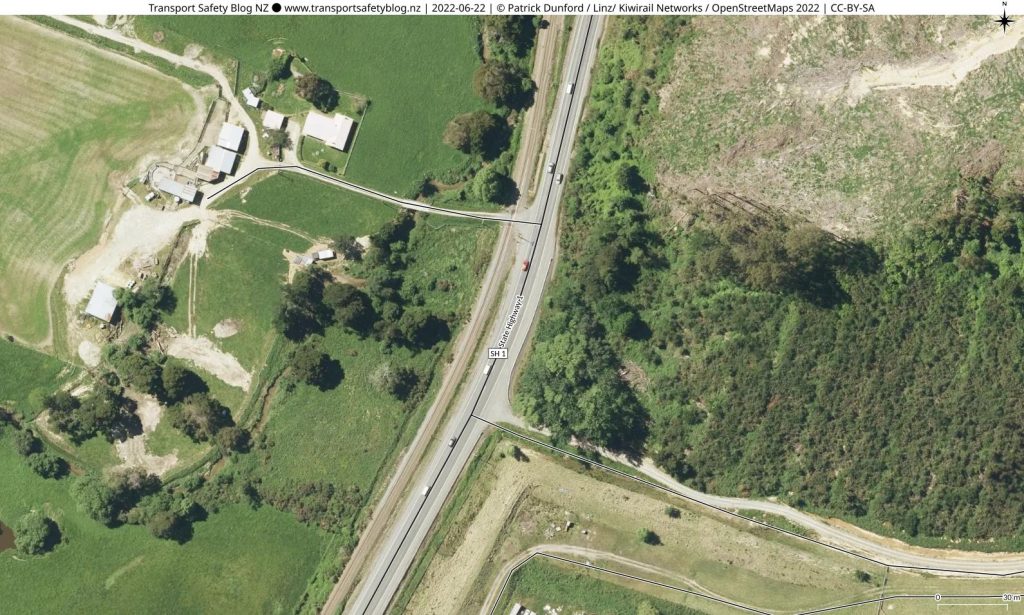News reports from Sunday 19th June are that a van carrying nine people crossed the centre line on a curve in SH1 near Koromiko and collided with a refrigerated truck heading south. Seven in the van were killed, whilst the driver of the truck received minor injuries. The location is believed to be at 41°20’2.70″S 173°58’0.87″E adjacent to 340.5 km on the Main North Line railway, that is 2.3 km north of Koromiko and 7 km south of Picton. The family traveling in the van had driven down from Auckland the previous week to attend a family funeral at Gore on Saturday and were on their way back north having driven through the night to meet a ferry sailing.

Police and the coroner will probably take a look at the driver’s level of alertness as the van had been driven directly from Gore soon after the funeral on Saturday and throughout the night with only a few hours ‘ break in Christchurch. The accident is said to have been one of NZ’s most deadliest road accidents (and the deadliest in the South Island in more than two decades). Some responses include:
- a call from “Dog and Lemon Guide” editor and road safety campaigner Clive Matthew-Wilson for the installation of median barriers. Matthew-Wilson claimed that speed reduction has been too much a focus for successive government as a way of addressing road safety. He suggested putting less freight into trucks and more onto rail was a solution that should be pursued.
- Richard Worrall, a former journalist, also pursued the trucking angle, suggesting the abolition of restrictions on road freight in 1982 had resulted in a massive social cost in terms of additional deaths and injuries on NZ highways. Worrall suggests the rail network and coastal shipping need more investment to take a greater share of freight, with one idea being a dedicated truck ferry between Wellington and Lyttelton.
There are many questions which have not been addressed to date, such as the standard of the highway, and whether the truck concerned (which appeared to be a refrigerated body without a trailer) was travelling long distance or a local run of the type that would be relatively uneconomic for short distances by rail. The highway between Christchurch and Picton, particularly north of Waipara, is notably hilly and windy, and has always been inferior to the highway south of Christchurch, this being mainly because of the low population between Christchurch and Blenheim. For the same reason, the Main South Line railway was completed many decades in advance of the Christchurch-Picton (Main North) line, which was not finished until 1945. Despite Worrall’s deprecations, rail freight is reasonably competitive on the Main North route for long haul and bulk services, as the highway is nowhere near as flat and straight, but has an uphill battle at present to regain the lost traffic volume since the 2016 earthquake forced its closure for almost a year, as the freight was shifted to coastal shipping, and a large area of the Picton shunting yards was torn up to make way for more trucks. Apart from the two new rail ferries currently under construction, the South Island railway network has attracted little government attention since then, with the main developments in boosting rail freight occurring on the Main South line and coming from major ports.
It has been asserted by the road freight industry that NZ’s major highways were allowed to deteriorate during the previous National government’s term and the decision to introduce HPMVs (trucks up to 62 tonnes gross weight) to highways in 2010 has probably been significant as the question would have always arisen as to whether this would have increased the maintenance needed to roads. The introduction of these larger trucks was seen at the time as directly challenging the use of rail freight for bulk loads and has almost certainly resulted in the loss of some freight from rail.
So largely the safety of the highway in the Picton area is the key question as to whether it is inherently suitable for the large volume of road freight being carried and the bigger picture of highways seemingly largely being funded according to the population of an area rather than the volume of traffic carried. New Plymouth is in a region where the mayor of that city has been vocal in questioning the allocation of NZTA funding for highways and this question will continue to be asked since large proportions of funding in recent years have gone into urban motorways, notably National’s RONS and Auckland development.
